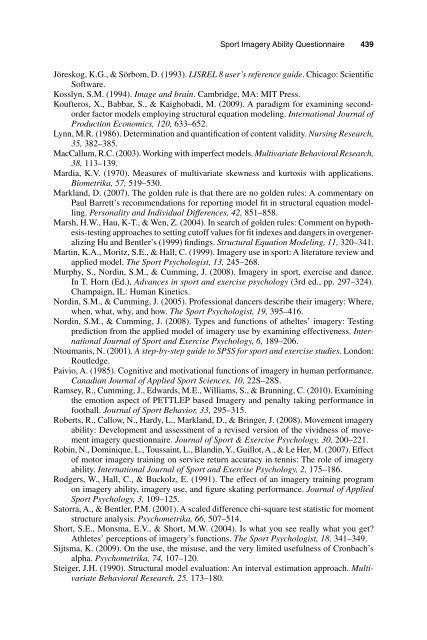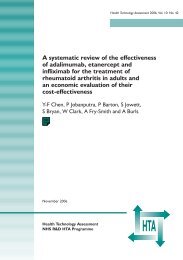Measuring Athlete Imagery Ability: The Sport ... - ResearchGate
Measuring Athlete Imagery Ability: The Sport ... - ResearchGate
Measuring Athlete Imagery Ability: The Sport ... - ResearchGate
You also want an ePaper? Increase the reach of your titles
YUMPU automatically turns print PDFs into web optimized ePapers that Google loves.
<strong>Sport</strong> <strong>Imagery</strong> <strong>Ability</strong> Questionnaire 439<br />
Jöreskog, K.G., & Sörbom, D. (1993). LISREL 8 user’s reference guide. Chicago: Scientific<br />
Software.<br />
Kosslyn, S.M. (1994). Image and brain. Cambridge, MA: MIT Press.<br />
Koufteros, X., Babbar, S., & Kaighobadi, M. (2009). A paradigm for examining secondorder<br />
factor models employing structural equation modeling. International Journal of<br />
Production Economics, 120, 633–652.<br />
Lynn, M.R. (1986). Determination and quantification of content validity. Nursing Research,<br />
35, 382–385.<br />
MacCallum, R.C. (2003). Working with imperfect models. Multivariate Behavioral Research,<br />
38, 113–139.<br />
Mardia, K.V. (1970). Measures of multivariate skewness and kurtosis with applications.<br />
Biometrika, 57, 519–530.<br />
Markland, D. (2007). <strong>The</strong> golden rule is that there are no golden rules: A commentary on<br />
Paul Barrett’s recommendations for reporting model fit in structural equation modelling.<br />
Personality and Individual Differences, 42, 851–858.<br />
Marsh, H.W., Hau, K-T., & Wen, Z. (2004). In search of golden rules: Comment on hypothesis-testing<br />
approaches to setting cutoff values for fit indexes and dangers in overgeneralizing<br />
Hu and Bentler’s (1999) findings. Structural Equation Modeling, 11, 320–341.<br />
Martin, K.A., Moritz, S.E., & Hall, C. (1999). <strong>Imagery</strong> use in sport: A literature review and<br />
applied model. <strong>The</strong> <strong>Sport</strong> Psychologist, 13, 245–268.<br />
Murphy, S., Nordin, S.M., & Cumming, J. (2008). <strong>Imagery</strong> in sport, exercise and dance.<br />
In T. Horn (Ed.), Advances in sport and exercise psychology (3rd ed., pp. 297–324).<br />
Champaign, IL: Human Kinetics.<br />
Nordin, S.M., & Cumming, J. (2005). Professional dancers describe their imagery: Where,<br />
when, what, why, and how. <strong>The</strong> <strong>Sport</strong> Psychologist, 19, 395–416.<br />
Nordin, S.M., & Cumming, J. (2008). Types and functions of atheltes’ imagery: Testing<br />
prediction from the applied model of imagery use by examining effectiveness. International<br />
Journal of <strong>Sport</strong> and Exercise Psychology, 6, 189–206.<br />
Ntoumanis, N. (2001). A step-by-step guide to SPSS for sport and exercise studies. London:<br />
Routledge.<br />
Paivio, A. (1985). Cognitive and motivational functions of imagery in human performance.<br />
Canadian Journal of Applied <strong>Sport</strong> Sciences, 10, 22S–28S.<br />
Ramsey, R., Cumming, J., Edwards, M.E., Williams, S., & Brunning, C. (2010). Examining<br />
the emotion aspect of PETTLEP based <strong>Imagery</strong> and penalty taking performance in<br />
football. Journal of <strong>Sport</strong> Behavior, 33, 295–315.<br />
Roberts, R., Callow, N., Hardy, L., Markland, D., & Bringer, J. (2008). Movement imagery<br />
ability: Development and assessment of a revised version of the vividness of movement<br />
imagery questionnaire. Journal of <strong>Sport</strong> & Exercise Psychology, 30, 200–221.<br />
Robin, N., Dominique, L., Toussaint, L., Blandin, Y., Guillot, A., & Le Her, M. (2007). Effect<br />
of motor imagery training on service return accuracy in tennis: <strong>The</strong> role of imagery<br />
ability. International Journal of <strong>Sport</strong> and Exercise Psychology, 2, 175–186.<br />
Rodgers, W., Hall, C., & Buckolz, E. (1991). <strong>The</strong> effect of an imagery training program<br />
on imagery ability, imagery use, and figure skating performance. Journal of Applied<br />
<strong>Sport</strong> Psychology, 3, 109–125.<br />
Satorra, A., & Bentler, P.M. (2001). A scaled difference chi-square test statistic for moment<br />
structure analysis. Psychometrika, 66, 507–514.<br />
Short, S.E., Monsma, E.V., & Short, M.W. (2004). Is what you see really what you get?<br />
<strong>Athlete</strong>s’ perceptions of imagery’s functions. <strong>The</strong> <strong>Sport</strong> Psychologist, 18, 341–349.<br />
Sijtsma, K. (2009). On the use, the misuse, and the very limited usefulness of Cronbach’s<br />
alpha. Psychometrika, 74, 107–120.<br />
Steiger, J.H. (1990). Structural model evaluation: An interval estimation approach. Multivariate<br />
Behavioral Research, 25, 173–180.
















